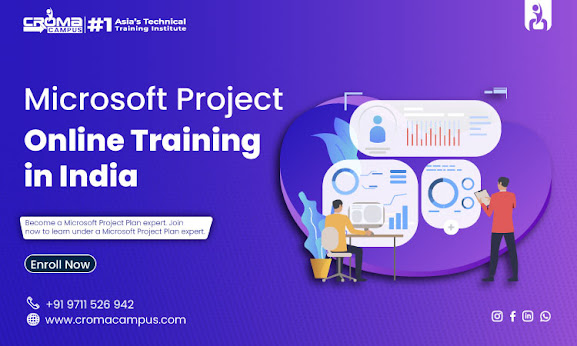Topmost benefits of learning Microsoft Project
Introduction
Microsoft Project is a powerful project management software that has become an industry standard for planning, tracking, and executing projects of all sizes. Learning Microsoft Project Online Training will provide individuals and organizations with a range of benefits, allowing for efficient project management and improved overall productivity.
In this article ahead, we will explore the topmost benefits of learning Microsoft Project.
Topmost benefits of learning Microsoft Project
· Comprehensive Project Planning: One of the primary advantages of learning Microsoft Project is the ability to create comprehensive project plans. The software offers a wide array of tools and features that allow users to define project goals, set timelines, allocate resources, and create task dependencies. With Microsoft Project, project managers can break down complex projects into manageable tasks and create a roadmap for successful project completion.
· Resource Management: Efficiently managing resources is crucial for project success. Microsoft Project enables users to define and allocate resources, including human resources, equipment, and materials, to specific tasks. By having a clear overview of resource availability and utilization, project managers can optimize resource allocation, avoid overbooking, and ensure that projects stay on schedule.
· Task Tracking and Progress Monitoring: In fact, it offers robust tracking and monitoring capabilities, allowing project managers to stay informed about the progress of tasks and overall project status. Users can update task statuses, track actual versus planned progress, and identify potential bottlenecks or delays. This real-time visibility enables timely decision-making, making it easier to address issues and keep projects on track.
· Schedule Optimization: Creating and maintaining an accurate project schedule is critical for meeting deadlines. Microsoft Project provides scheduling tools that allow project managers to define task durations, dependencies, and constraints. By utilizing features like the critical path method, users can identify tasks that directly impact project completion dates and optimize the schedule accordingly, minimizing delays and maximizing efficiency.
· Collaboration and Communication: Effective collaboration is key to successful project management. Microsoft Project offers collaborative features that enable team members to share project information, update task statuses, and communicate through integrated tools. Project stakeholders can access project data, view progress reports, and contribute to discussions, fostering transparency, alignment, and improved communication among team members.
· Reporting and Data Analysis: Furthermore, it provides a range of reporting and data analysis capabilities, allowing project managers to generate insightful reports and visualize project data. Users can create Gantt charts, resource histograms, and other graphical representations to present project progress, resource utilization, and budgetary information. These reports help stakeholders gain a comprehensive understanding of project performance, enabling informed decision-making and effective communication.
· Integration with Other Tools: Microsoft Project integrates seamlessly with other Microsoft Office tools, such as Excel, Word, and PowerPoint. This integration streamlines data sharing, eliminates duplicate data entry, and enhances productivity. Users can import and export data, generate reports, and leverage the strengths of multiple software applications, creating a unified project management ecosystem.
Is Microsoft Project a complex course to learn?
At first, by hearing its name, you might consider this course a bit complex one's but it’s eventually not that difficult to master. Well, this specific software offers a wide range of features and capabilities, and mastering all of its functionalities can take time and practice.
Here are a
few factors that contribute to the perceived complexity of learning Microsoft
Project:
- Microsoft Project has a
comprehensive interface with various menus, tabs, and options. Navigating
through the software and understanding how each feature works can be
overwhelming initially.
- To effectively use
Microsoft Project, it is essential to have a solid understanding of
project management principles, such as defining project goals, creating
work breakdown structures, managing resources, and setting dependencies.
Learning these concepts alongside the software itself can add to the
learning curve.
- Microsoft Project
offers advanced features like customizing project views, creating complex
formulas, setting up custom fields, and utilizing macros for automation.
These advanced functionalities require deeper knowledge and experience to
leverage their full potential.
- While Microsoft Project
can integrate with other Microsoft Office tools, such as Excel and
PowerPoint, understanding how to leverage this integration effectively may
require familiarity with those tools as well.
Despite the initial complexity, Microsoft Project provides a user-friendly interface and offers various learning resources, including official documentation, tutorials, online courses, and community forums. With dedication, practice, and a structured learning approach, individuals can gradually grasp the concepts and functionalities of Microsoft Project, making it a valuable tool for project management.
Conclusion
From the
information listed above, it’s evidently clear that acquiring Microsoft
Project Online Training in India will offer numerous benefits to individuals and
organizations involved in project management. From comprehensive project
planning and resource management to efficient task tracking and collaboration,
the software provides a robust platform for successful project execution. By
mastering Microsoft Project, professionals can enhance their project management
skills and contribute to the seamless execution of projects, ultimately leading
to improved productivity and project success.



Comments
Post a Comment